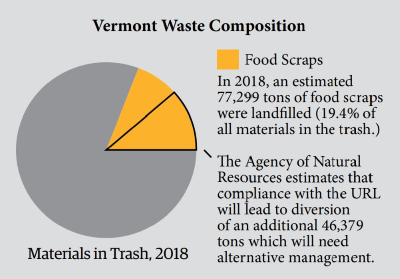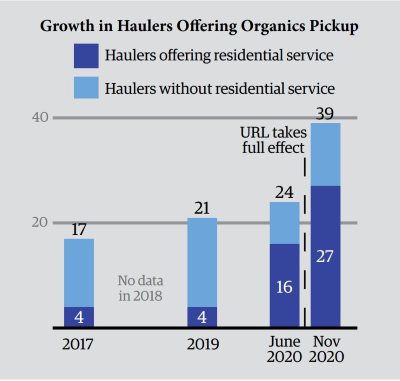
 Critical goals are achieved when food scraps, manure, and other organic materials are removed from the waste stream and transformed into compost. Composting operations benefit the environment, create jobs, produce important agricultural inputs, and provide community services. When organic materials are diverted from landfills, where they would emit potent greenhouse gases, carbon emissions are avoided. In addition, converting this “waste product” into high-quality compost for use on Vermont land provides farmers with a valuable material that builds soil health and improves water quality (see Water Quality brief). Vermont’s Universal Recycling Law (URL) provides a framework for pursuing organics resource management goals, but more work remains to build an ecologically efficient and economically sustainable model for localized, decentralized composting.
Critical goals are achieved when food scraps, manure, and other organic materials are removed from the waste stream and transformed into compost. Composting operations benefit the environment, create jobs, produce important agricultural inputs, and provide community services. When organic materials are diverted from landfills, where they would emit potent greenhouse gases, carbon emissions are avoided. In addition, converting this “waste product” into high-quality compost for use on Vermont land provides farmers with a valuable material that builds soil health and improves water quality (see Water Quality brief). Vermont’s Universal Recycling Law (URL) provides a framework for pursuing organics resource management goals, but more work remains to build an ecologically efficient and economically sustainable model for localized, decentralized composting.
 Compost production at farms, community sites, certified facilities, and homes is steadily increasing, largely due to mandated organics diversion in the URL. Food scrap hauling services now provide approximately 80% of Vermont towns with commercial service, including some residential curbside service, and over 100 transfer stations now accept residential food scraps. In 2017, Vermont residents brought over 13,000 tons of food scraps to composting facilities, and composted an estimated 27,000 tons at home. While progress is being made in diverting food scraps from the landfill, most Vermont composting operations have the potential to increase the volume they handle, but are competing against other diversion methods with less benefit to agricultural producers and/or the environment. Regardless of business model, compost operations face challenges both as service providers (i.e., collecting food scraps) and as producers of finished compost products.
Compost production at farms, community sites, certified facilities, and homes is steadily increasing, largely due to mandated organics diversion in the URL. Food scrap hauling services now provide approximately 80% of Vermont towns with commercial service, including some residential curbside service, and over 100 transfer stations now accept residential food scraps. In 2017, Vermont residents brought over 13,000 tons of food scraps to composting facilities, and composted an estimated 27,000 tons at home. While progress is being made in diverting food scraps from the landfill, most Vermont composting operations have the potential to increase the volume they handle, but are competing against other diversion methods with less benefit to agricultural producers and/or the environment. Regardless of business model, compost operations face challenges both as service providers (i.e., collecting food scraps) and as producers of finished compost products.
Despite URL education efforts, many Vermont residents remain confused about source separation, resulting in significant contamination of food scraps with non-compostables (e.g., PLU stickers). Furthermore, many large stores combine both packaged and unpackaged food when collecting food scraps, which are then hauled out-of-state to depack facilities and run through a depackaging machine. The depacking process leaves microplastic residuals in the resulting slurry, bringing into question the suitability for use as agricultural compost.
Markets for finished compost have not kept pace with the increasing production volume. Poor understanding of the value and uses of compost lead to resistance to its use in large-scale public and private projects. This is compounded by the absence of quality standards, accepted Best Management Practices (BMPs) for compost use, and standardized product specifications.
